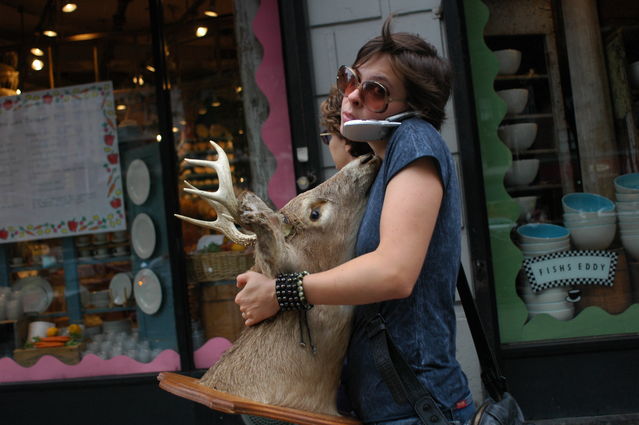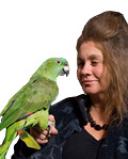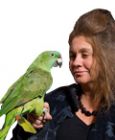Media
The Voice of Image: Exploring the Psychology of Photography
An interview with Jo-Anne McArthur.
Posted February 13, 2016

The eye should learn to listen before it looks. - Robert Frank
Jo-Anne McArthur is a Toronto-based photojournalist whose work spans a vast range of subjects. However, she is perhaps best known for her work over the last fifteen years as an investigator and chronicler focused on nonhuman animals. This pioneering work is the subject of a documentary, The Ghosts in Our Machine.
In this interview, she reflects on the nature of her work and the interplay of psyche and society through the medium of photography in the landscape of human-animal relationships.
Jo-Anne, in the last few years you have generated a stream of award-winning studies focused on non-human animals, including the We Animals project and forthcoming book. In fact, you are considered to be the first, if not, until recently, “the” animal rights photojournalist. Can you talk about this and what this moniker entails?
JM: First, I describe myself as a “photojournalist” and not a photographer because the intent of a photojournalist is just like any other written-word news reporter- except I use images to reveal and report on what is going on to the public. There is art involved, but it is art in service to its subject. Moreover, photography as journalism is an explicit medium of dialogue between the subject and the viewer. This is key in the case of animals. They are denied voice, both literally and legally. Chimpanzees talk, Chickens talk, Rabbits talk – they just don’t use words like we do and humans are the ones in power to decide who can talk and who can’t. My goal is to provide a way for animals to inform humans through these documents, my photographs. As an “animal rights” photojournalist, I try to use my camera to hear and record what animals are saying and feeling. Not what humans want to see and hear, but actually what is going on for that particular animal individual.

Say a little more about the difference between a photo that shows “what humans want” and “what is actually going on for a particular animal”?
JM: Pictures of animals are everywhere. Greeting cards, art shows, magazines, clothes, television, movies—you name it. Animals have been the subject, and object, of photographers and artists forever and are thus vulnerable to interpretation. Traditionally, they have largely served as a source of interest for the artist and the viewer, for our benefit and entertainment. Even a lot of magazines and programs that focus on wildlife conservation and animal stories tend to portray Lions, Bears, and other animals in ways that please and entertain us. The animals depicted are used for human purposes.
My work in animal rights began as a street photographer, shooting what we could all see from the streets. This evolved into the documentation of cruelty and inhumane treatment; images which sometimes had to be obtained surreptitiously - Chickens in factory farms, the dairy industry, fur farms, and so on.These videos and photos helped animal advocates reveal and communicate what is so often hidden. It was during this time that I started to look even deeper, beyond reportage, to hear, with my camera, the inner lives and experiences of farmed and free living species whose lives and souls are destroyed by human excess.

Fox on fur farm, Europe.
How can you tell that the way in which you photograph—the when, how, and who you photograph—is not “what people want to see”? In other words, how does your work reflect what an individual animal is actually feeling and experiencing and not simply a reflection of your own, or the viewer’s, projection?
JM: I don’t have to worry about that so much because the photos show where the animals are and that often says it all. I don’t have to “tell” anyone what or how to feel. We can see directly. My images are both a window and a mirror; a window into our treatment of animals, which mirrors society and the human psyche. It’s very uncomfortable for people. For example, I worked with film maker Karol Orzechowski on a short film called The Rhythm, which is a film about Rabbits, but it’s more so about what we do to Rabbits. It shows the cold, mechanical rationale of the kill line. It chronicles who and what lies within the package of Rabbit meat. By including details of the Rabbits’ faces in context of the machinery of killing and the people doing the killing, the real subject is us, the viewers, and the society in which we live.
A photo or film is social commentary such as the image I took of a young woman walking down a sidewalk in Manhattan, talking on her cell phone and carrying the taxidermied head of a deer. Though the animal is central to the image, as they often are in my photographs, the animal is secondary to the context. The photo aims to show how animals are so often invisible while in plain view. The photo is about her, the young woman, and our, wants, and uses, of animals, whether they are alive and whole, or in parts. The We Animals images are intended to speak to the audience about the world we’ve taken apart and reconstructed for animals. I leave what to think or feel to the viewer. The biggest challenge for me is how to provide important information without overwhelming the viewer into paralysis.
What do you mean by “paralysis”?
JM: Animal abuse and exploitation are not pretty which is why factory farms and slaughterhouses conduct their business behind windowless walls. Animal exploitation is so deeply ingrained in every aspect of modern human society—the “pet” trade, entertainment, food, clothing, biomedical research, schools, furniture, holidays— that when we realize what is really going on, the immensity of the suffering by billions and billions of animals just so that we can be comfortable, we often shut down and turn off. For a lot of people it’s hard to take it all in and hard to know where to start to make a change. Thus, I understand that my images demand a lot from the viewer, who is not used to being challenged about issues as normalized as animal use.

This is why some of my images are accompanied by the request, ”Please don’t turn away.” When I started working as an investigator, literally filming the guts of a slaughterhouse, I was so outraged and so inundated with the horror that I felt everyone had to see. I was angry if anyone acted complacent or indifferent. But I have changed over the years. I still want everyone to know “the truth”— I haven’t changed in that regard – but I have developed deep compassion for our species, and I try to meet my audience where they are. Humans have been and are also victims of what is being done to animals.
Can you explain what you mean by humans also being victims of the animal exploitation industries?
JM: I’ll give you a recent example. After one of my lectures, a dairy farmer who must have been over 70 came up to talk with me. He was clearly very upset about what I had showed and said about veal being “produced,” that dairy Cows are killed at ages four to six years when they are considered “spent,” but that they could live much longer natural lives if we didn’t tax their bodies so, and so on. He addressed all I’d said because he felt attacked, but I countered by saying, “I think you can agree with me that modern dairy farming is not kind to the animal.” He could not disagree. He knew exactly what the process was, he had witnessed it for decades. He could not disagree that Cows are sentient with feelings of love and care for their babies, but he remained upset and felt personally attacked. I said that I don’t aim to attack individuals in my work, I try to show that modern mechanized “farming” has gone very wrong and the victims are the animals. He couldn’t disagree.

My work reveals what people do, knowingly or not. The images require work from the viewer. Images get into the mind, the psyche of people, and when that happens, they are hard to un-see. That is one reason I love working with images – it’s a way to begin an open honest dialogue. Social issue photographers need to see their images as a beginning, not an end. More than ever, I am mindful of this, and try as best I can to support people dealing with these profound challenges by being kind, patient, and remembering that everyone, me included, has their blind spots.
You allude to personal change. Can you talk about how this work has affected you psychologically?
I experienced what many, or most, people encounter on the path of activism. One day, something clicks inside, and you have to speak out and do something. You come out guns blazing, angry and passionate, wanting everyone to know what is going on. The abuse of animals is catastrophic and the suffering of billions at our hands is immediate and so I wanted (and want) everyone to realize who was that piece of steak or strip of bacon on the plate, and what he or she went through to be made into a piece of meat. After years of the relentless agony watching so much suffering and cruelty juxtaposed to mass indifference, it messes with you. That is why so many activists burn out and drop out. We become so consumed with grief, anger, and frustration, that it is no longer possible to live happily. It happened to me. I’d find myself driving along somewhere and, all of a sudden, breaking down in tears. Images of Pigs in gestation crates, or with prolapsed uteruses panting in the suffocating summer heat of a transport truck, Chickens cramped into tiny cages, Bears in bear bile farms – all the memories would replay like a nonstop movie in my head.

The scenes don’t stop when you leave the fur or farm factory. Investigations take their toll. You work all night and so don’t get a lot of sleep. You witness thousands of animals who look at you, their eyes are full of questions: “Why is this happening? What is going to happen next?” They’re terrified. Then after leaving, you go back and have to replay the experience again, go through and edit the images and so you see their faces over and over. I’ve waded through two bouts of depression and a diagnosis of PTSD. I had to learn how to compartmentalize in a healthy way and not stuff the feelings down.
I decided that if I was going to continue to help animals, I needed to be able to function and be happy, too. In order to be compassionate, good people, we are encouraged to feel what others are feeling, to stand in their hooves and feet. I still do this, of course, but not all the time. I actively decide when and when not to think about the Chickens and Rabbits. I go out to movies, see friends and laugh. I don’t need to be motivated by pain all the time. Animals need me to have longevity in my work and that requires me to be happy and healthy in order to function well. I think that accepting my own limits has made me have greater compassion for those of others.

Given your psychological evolution, do you still consider yourself an “animal rights photojournalist”?
JM: That's a good question. I think that the label has been accurate and useful for many years. I use photography as a voice for animal rights and for the people working as animal advocates. The label had an impact. I still receive letters almost every day from up and coming activists and photographers who tell me that my work as an AR (animal rights) photographer has inspired them and given them a path to advocate for animals. But over time, my focus has evolved to what might be described at the space in-between—the human condition as well as the animal condition. So, for a number of reasons, I have thought about “re-branding” myself because, even though there have been huge strides in how people view animals—the vegan movement which is exploding, campaigns against wildlife exploitation and so on – most media don’t want to feature images that make people uncomfortable.
People love animals but they want to see them the way they want to and that does not include a Rattlesnake being skinned alive or a Cat being vivisected in a university classroom and of course the media knows that. They also have shareholders and advertisers to consider. Even when animal suffering is shown in mainstream media, it always leaves an escape for the viewer, a way to somehow say or believe “that everything is going to be okay.” Animal rights photography and film don’t do that. They disrupt consensus reality. The basic message is: “This suffering animal will not escape. This animal, and billions more, will die and you are part of why this happens.” In a sense, the viewer becomes trapped like the animal and I think this what a lot of people feel unconsciously when they come across these kinds of images.

Can you say a little about your philosophy now and an example of a current project?
JM: My work is evolving to meet people where they are at. The human mind and psyche are a continuum and in constant flux. My job, as much as it can be, is to start a dialogue—via my photography and now via lectures as well—at that specific point in time, space, and psyche. Though my work upsets people, I want to catch their interest, engage their heart, and help them begin to see. I want my work to invite people to find solutions. I’ve spent the last fifteen years pointing out the problems. Now, I try to provide opportunities for people, empower them to make changes which will help animals and help the world. I also want to bring the joy of animal advocacy to people’s attention.

This is reflected in my new ongoing project, Unbound. It’s a multimedia/book project in collaboration with Brock University art historian, Keri Cronin, which recognizes women around the world at the forefront of animal advocacy, in both contemporary and historical contexts. In Europe and North America especially, almost 80% of animal advocates have been women. All of these women, worldwide, should be celebrated. Through Unbound, we hope to inspire people to do the important kind of work that so many women advocates are doing. There is so much negativity about humans today. We want to show that there’s an awful lot of good being done, and that immense joy can be found in kind and compassionate living with animals.





